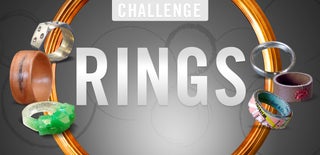Introduction: Infinite Possibilities Ring: Interchange and Customize
My typical jewelry habits are to wear the same items every day. Although I may switch out a different pendant on the same chain based on a particular outfit, I'm happy with my favorite items. I thought it would be great to bring the interchangeability of my necklace to a ring. This ring allows me to attach anything with a hole (or anything I can drill a hole into) onto my ring.
Check out the last step for all the different combinations I've come up with so far.
Materials:
scrap wood
nut and bolt(s) - various lengths with the same diameter are nice to have but not necessary
drill with various sizes of bits
veg tanned leather
small leather rivets
various items with holes in the middle (ex: beads and scrapbooking items)
sandpaper
electric sander (optional)
pencil
x-acto or boxcutter
metal ruler
E-6000 or other heavy duty glue
clamp or vice
saw
leather punch
Step 1: Cutting Template
Mark the length of your bolt on the end of the wood. I used a 1/2" length/size 4-40.
Trace the inside of a personal ring to get an appropriate curve for your finger. I traced mine just above the bottom of the bolt mark with the assumption that whatever I ultimately put under the bolt will push it up enough to keep it from bumping into my finger.
Use your ruler to draw a straight line from each edge of the curve to the end of the board.
Continue those lines onto the edge of the board.
Step 2: Adding the Nut
Choose a drill bit that is slightly smaller than the nut.
Use the guidelines on the edge of the board to drill a hole in the center only as deep as the nut's thickness.
Sand the edge.
Hammer the nut into the hole.
Pop the nut back out and glue it in with E-6000 while being careful to not get glue on the threads.
Step 3: Cut and Sand
Cut from the edge to the sides of the curve on each side.
Cut the curve.
Sand the woodblock down until it is smooth and even.
Step 4: Leather
Mark cutting lines on the back of the leather using the wood block as a guide for the length and width.
Use a metal ruler and X-acto or boxcutter to cut the leather.
To add texture to the leather, wet it and use leather stamps or even roll a large bolt across it.
Mark the placement of your rivet holes so that they will fit within the edges and not overlap in the center. You'll be using only the post side of the rivets not the backs.
Let the leather dry or dry it with a blow dryer.
Step 5: Attaching Leather
Use a leather punch to put holes on your marks.
Trace the holes onto the wood block.
Drill holes in the wood block on your marks only as deep as necessary to accommodate the rivets.
Step 6: Attaching Leather Continued
Add E-6000 to the holes in the wood block.
Add the leather and then the rivets.
Put the ring in a vice or clamp to press the rivets into the holes firmly while the glue dries. Use a rag or bit of cloth to keep the texture of the vice from imprinting on the leather.
Allow to dry for at least a few hours if not overnight.
Step 7: Fit
Wet the bottom of the leather and wear the ring for a while. Be sure to close your hand tightly. This will create a custom fit just for your finger.
Step 8: Customize
Gather items with holes.
I also picked up some bolts of the same diameter but different lengths to accommodate larger items.
Place an item on the bolt and screw it in.
If you don't like the screw to show on top or the bolt isn't long enough, you could countersink the bolt into an item like I did with this pink wooden bead.
Step 9: Infinite Possibilities
Mix and match your items to fit your mood or outfit. Don't forget that you can also drill a hole in items that don't have one to add them to your ring.
I'd love to hear suggestions for items that could be added to this ring in the comments. Coins or washers could be great for example.

First Prize in the
Rings Challenge

Participated in the
Guerilla Design Contest

Participated in the
Small Spaces Contest













